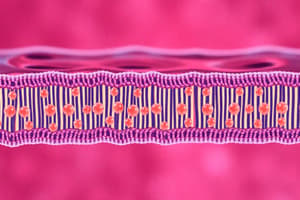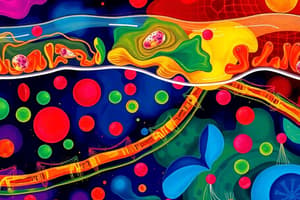Podcast
Questions and Answers
What is required for the polymerization of tubulin to occur?
What is required for the polymerization of tubulin to occur?
- Actin filaments
- Cell membrane components
- Contractile rings
- Microtubular organizing centers (correct)
What is the main function of microtubules during cell division?
What is the main function of microtubules during cell division?
- Forming the mitotic spindle (correct)
- Facilitating muscle contraction
- Supporting the plasma membrane
- Transporting organelles
What is a primary function of microtubules within a cell?
What is a primary function of microtubules within a cell?
- Supporting cellular metabolism
- Maintaining lipid bilayer integrity
- Facilitating the contractile ring
- Intracellular transport of vesicles (correct)
Which characteristic distinguishes microtubules from other filament types?
Which characteristic distinguishes microtubules from other filament types?
How are centrioles structured?
How are centrioles structured?
Which of these processes are microtubules NOT involved in?
Which of these processes are microtubules NOT involved in?
What is the diameter of microtubules?
What is the diameter of microtubules?
Which of the following is NOT a function of microtubules?
Which of the following is NOT a function of microtubules?
What is the main function of the nucleus within a cell?
What is the main function of the nucleus within a cell?
Which component of chromatin is visible during the cell division process?
Which component of chromatin is visible during the cell division process?
What is the primary function of ribosomes synthesized in the nucleolus?
What is the primary function of ribosomes synthesized in the nucleolus?
Which type of chromatin is characterized as being transcriptionally inactive?
Which type of chromatin is characterized as being transcriptionally inactive?
What role do proteasomes play in cellular function?
What role do proteasomes play in cellular function?
What is the dominant form of chromatin in active cells such as liver cells?
What is the dominant form of chromatin in active cells such as liver cells?
Which proteins are synthesized by attached ribosomes on the RER?
Which proteins are synthesized by attached ribosomes on the RER?
What does an increased euchromatin/heterochromatin ratio indicate about a cell?
What does an increased euchromatin/heterochromatin ratio indicate about a cell?
What happens when there is a defect in proteasomes?
What happens when there is a defect in proteasomes?
What is the diameter range of the filaments that form part of the histological structure mentioned?
What is the diameter range of the filaments that form part of the histological structure mentioned?
During which cell cycle stage does the nucleus spend 90% of its time?
During which cell cycle stage does the nucleus spend 90% of its time?
Which of the following morphological features are characteristic of apoptotic cells?
Which of the following morphological features are characteristic of apoptotic cells?
Which component of the nucleus is responsible for synthesizing ribosomal RNA?
Which component of the nucleus is responsible for synthesizing ribosomal RNA?
Which statement about chromatin is NOT correct?
Which statement about chromatin is NOT correct?
What is the primary characteristic of stem cells?
What is the primary characteristic of stem cells?
Which type of cells represents a stable population that divides episodically?
Which type of cells represents a stable population that divides episodically?
Which phase is NOT part of the division of the cell cycle?
Which phase is NOT part of the division of the cell cycle?
What is the role of macrophages in apoptotic processes?
What is the role of macrophages in apoptotic processes?
What is the primary function of the phosphate group in phospholipids?
What is the primary function of the phosphate group in phospholipids?
Which type of protein is firmly attached to the cell membrane?
Which type of protein is firmly attached to the cell membrane?
What role do the fatty acid tails of phospholipids play in membrane structure?
What role do the fatty acid tails of phospholipids play in membrane structure?
What type of substances can most easily pass through the cell membrane due to its selective permeability?
What type of substances can most easily pass through the cell membrane due to its selective permeability?
Which of the following best describes transmembrane proteins?
Which of the following best describes transmembrane proteins?
What is a key functional role of carbohydrates in the cell membrane?
What is a key functional role of carbohydrates in the cell membrane?
What aspect of phospholipids allows them to contribute to the selective permeability of the cell membrane?
What aspect of phospholipids allows them to contribute to the selective permeability of the cell membrane?
What characteristic distinguishes peripheral proteins from integral proteins?
What characteristic distinguishes peripheral proteins from integral proteins?
Flashcards are hidden until you start studying
Study Notes
Cell Membrane Components
- Phospholipid Structure: Composed of charged, polar hydrophilic heads and non-polar, hydrophobic fatty acid tails.
- Organization: Heads face aqueous solutions while tails face inward, forming a bilayer.
- Selective Permeability: Allows passage of small, non-polar, and fat-soluble substances.
Membrane Proteins
-
Peripheral (Extrinsic) Proteins:
- Small molecules, loosely attached to membrane surfaces.
- Located outside the lipid bilayer.
-
Integral (Intrinsic) Proteins:
- Larger, firmly attached molecules embedded within the lipid bilayer.
- Some extend across the entire membrane (transmembrane proteins).
Protein Synthesis
- Free Ribosomes: Synthesize proteins for internal cell use (e.g., mitochondria, nucleus).
- Attached Ribosomes (RER): Produce proteins to be secreted or sent to cell membranes and lysosomes.
Proteasomes
- Function: Barrel-shaped organelles that degrade cytoplasmic proteins tagged with ubiquitin.
- Importance: Removes excess and improperly folded proteins, and destroys viral proteins; defects can lead to diseases like Alzheimer’s.
Cytoskeleton Components
-
Microfilaments (Actin Filaments):
- Diameter: 5-7 nm, consisting of F-actin formed by G-actin polymerization.
- Functions include cell support, muscle contraction, and shape changes (endocytosis/exocytosis).
-
Microtubules:
- Diameter: 24 nm, hollow cylinders made of α and β tubulin subunits.
- Involved in cell shape, intracellular transport, and formation of mitotic spindles during cell division.
Centrosome and Cell Division
- Centrosome Structure: Two cylindrical structures (centrioles) that are perpendicular, involved in microtubule organization.
- Function: Form mitotic spindles for cell division and regulate microtubule growth.
Nucleus Structure and Function
- Largest Organelle: Contains DNA and is essential for cell life.
- Components: Nuclear envelope, chromatin, nucleolus.
Chromatin Types
- Euchromatin: Extended, transcriptionally active, visible in active cells (e.g., liver).
- Heterochromatin: Condensed, transcriptionally inactive, predominant in inactive cells (e.g., small lymphocytes).
Cell Cycle Phases
- Interphase: Accounts for 90% of the cell cycle, includes G1, S (synthesis), and G2 phases.
- Mitosis: Process of cell division.
Apoptosis
- Active Cell Death: Morphological changes include chromatin condensation, nuclear fragmentation, and membrane blebbing, resulting in apoptotic bodies.
Stem Cells
- Definition: Undifferentiated cells capable of self-renewal and differentiation.
- Types:
- Embryonic stem cells (found in embryos).
- Adult stem cells (located in tissues like bone marrow and skin).
- Static Cell Populations: Cells that no longer divide (e.g., CNS and cardiac muscle).
- Stable Cell Populations: Cells that divide slowly to maintain tissue structure (e.g., liver cells).
- Rapidly Renewing Populations: Cells that frequently divide (e.g., blood cells and skin epithelium).
Studying That Suits You
Use AI to generate personalized quizzes and flashcards to suit your learning preferences.




